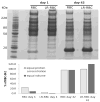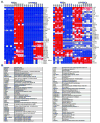Proteomic analysis of the supernatant of red blood cell units: the effects of storage and leucoreduction
- PMID: 23663258
- PMCID: PMC3744597
- DOI: 10.1111/vox.12042
Proteomic analysis of the supernatant of red blood cell units: the effects of storage and leucoreduction
Abstract
Background: Red blood cell (RBC) transfusion is a life-saving intervention for critically ill patients; however, it has been linked to increased morbidity and mortality. We hypothesize that a number of important proteins accumulate during routine storage of RBCs, which may explain some of the adverse effects seen in transfused patients.
Study design: Five RBC units were drawn and divided (half prestorage leucoreduced (LR-RBC) and half left as an unmodified control (RBC). The supernatant was separated on days 1 and 42 of storage and proteomic analyses completed with in-gel tryptic digestion and nano-liquid chromatography tandem mass spectrometry.
Results: In RBC supernatants, 401 proteins were identified: 203 increased with storage, 114 decreased, and 84 were unchanged. In LR-RBC supernatant, 231 proteins were identified: 84 increased with storage, 30 decreased, and 117 were unchanged. Prestorage leucoreduction removed many platelet- and leucocyte-derived structural proteins; however, a number of intracellular proteins accumulated including peroxiredoxins (Prdx) 6 and latexin. The increases were confirmed by immunoblotting, including the T-phosphorylation of Prdx-6, indicating that it may be functioning as an active phospholipase. Active matrix metalloproteinase-9 also increased with a coinciding decrease in the metalloproteinase inhibitor 1 and cystatin C.
Conclusion: We conclude that a number of proteins increase with RBC storage, which is partially ameliorated with leucoreduction, and transfusion of stored RBCs may introduce mediators that result in adverse events in the transfused host.
Keywords: leucoreduction; proteins; red blood cell; storage; supernatant; transfusion.
© 2013 International Society of Blood Transfusion.
Conflict of interest statement
The authors have no financial conflicts of interest with the submitted manuscript.
Figures






References
-
- Transfusion Reactions. 3. Bethesda: AABB Press; 2007.
-
- Koch CG, Li L, Sessler DI, et al. Duration of red-cell storage and complications after cardiac surgery. N Engl J Med. 2008;358:1229–1239. - PubMed
-
- Purdy FR, Tweeddale MG, Merrick PM. Association of mortality with age of blood transfused in septic ICU patients. Can J Anaesth. 1997;44:1256–1261. - PubMed
-
- Silliman CC, Boshkov LK, Mehdizadehkashi Z, et al. Transfusion-related acute lung injury: epidemiology and a prospective analysis of etiologic factors. Blood. 2003;101:454–462. - PubMed
-
- Weinberg JA, McGwin G, Jr, Griffin RL, et al. Age of transfused blood: an independent predictor of mortality despite universal leukoreduction. J Trauma. 2008;65:279–282. - PubMed
Publication types
MeSH terms
Substances
Grants and funding
LinkOut - more resources
Full Text Sources
Other Literature Sources
Research Materials
Miscellaneous

